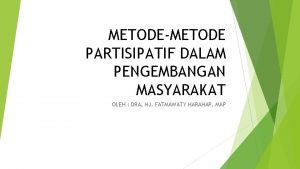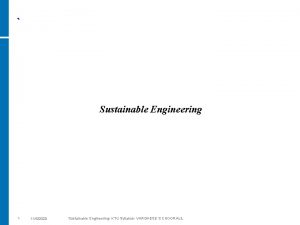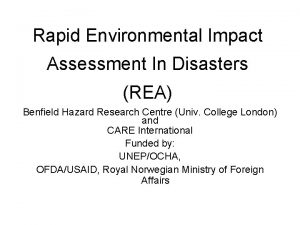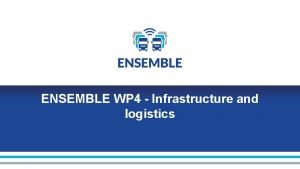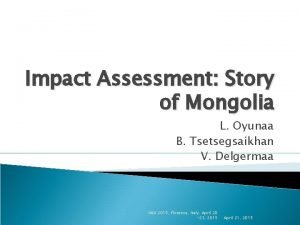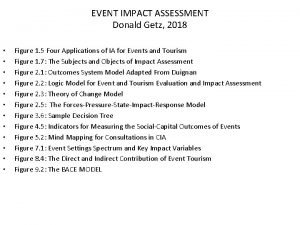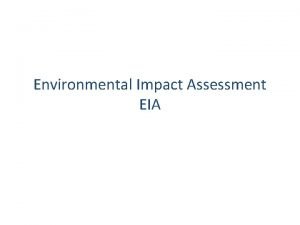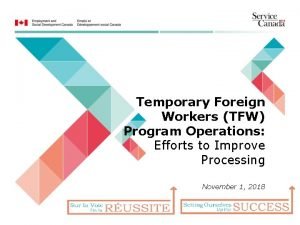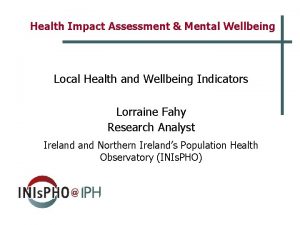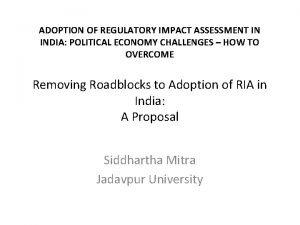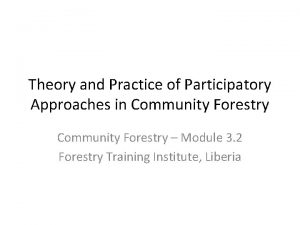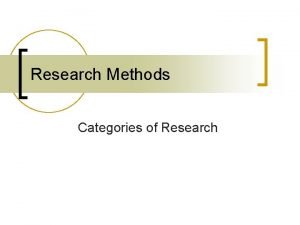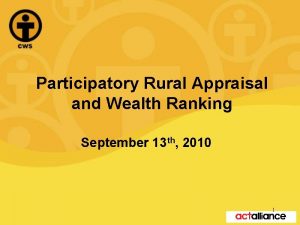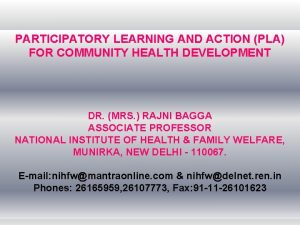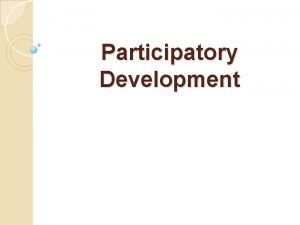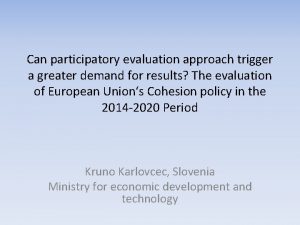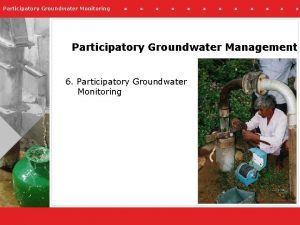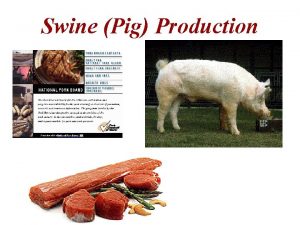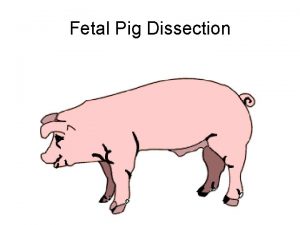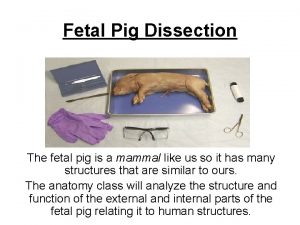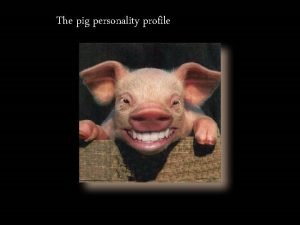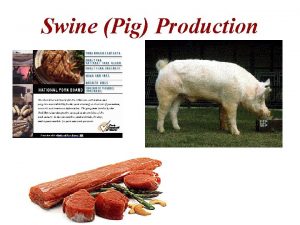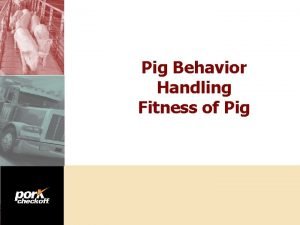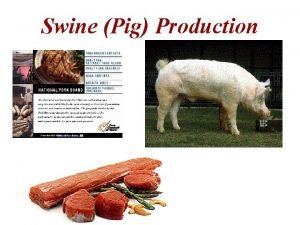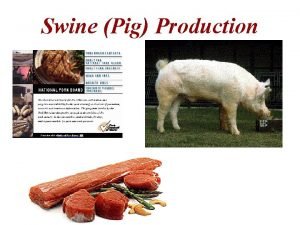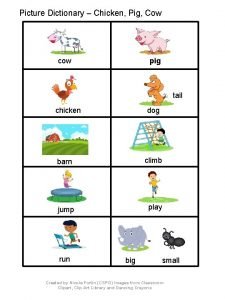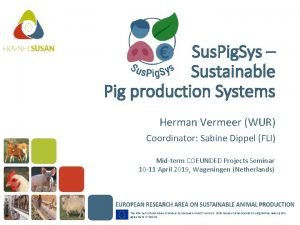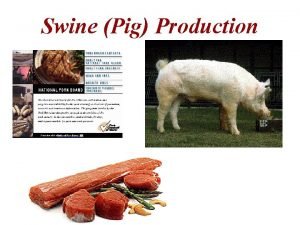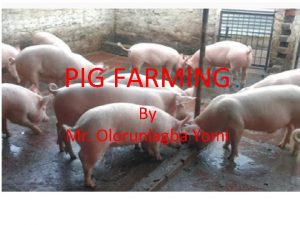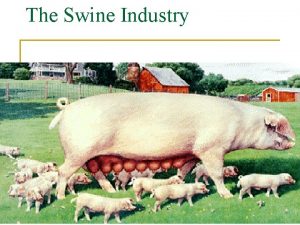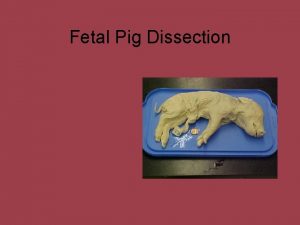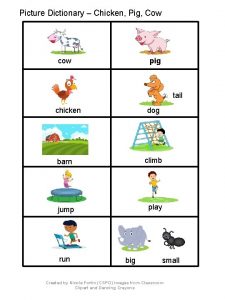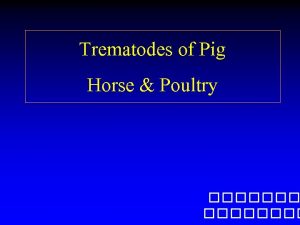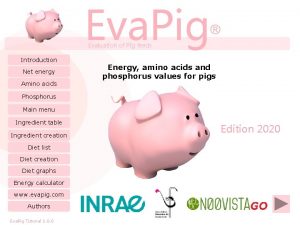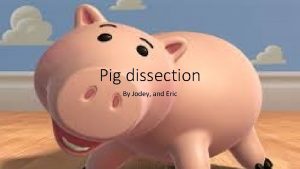Participatory Impact Assessment following training of smallholder pig
























- Slides: 24

Participatory Impact Assessment following training of smallholder pig farmers on biosecurity for the control of African swine fever in Uganda Michel Dione, ILRI Second Participatory Epidemiology Network for Animal and Public Health Conference: Participatory Approach to One Health, Khon Kaen, Thailand, 10 -12 January 2018

African swine fever disease Reddening of the skin Petechial hemorrhages in the cortex and renal pelvis. Splenomegaly (not specific for ASF) Up to 100% herd mortality

African swine fever in Uganda • Major pig health constraint to farmers • Endemic with recurrent outbreaks • High mortality rate

rural-rural-urban-urban a TC m Go o on uk M ya ng e Ss en go a uz te e. Bu tw do - Ny en Ka a si pi am an a. Ky ab ak m Ki Ky ne r er u en j bo Ka Nt a by Bu gu lu m a a dw en w m Na yu nw ta Ki a ak in go uk Ky an am Kk Proportion of farmers (%) Fate of pigs affected by ASF according farmers (n=350 farmers) 120 100 80 60 slaughter die 40 recover sale 20 0

Constraints to African swine fever control • No effective treatment and vaccine • Impact can only be minimized through the adoption of biosecurity measures along the pig value chains • Lack of pig producers’ knowledge on best practices in biosecurity and husbandry is an important contributing factor to the persistence of ASF outbreaks • Weak disease surveillance systems (disease reporting and movement control) • Poor hygiene and processing practices Capacity building of farmers has been identified as an intervention in order reduce the incidence of the disease, hence improve productivity of pig herds

Objective of the study Investigate the efficacy of participatory training in increasing knowledge of biosecurity protocols and in the readiness of farmers to implement protocols in order to reduce productive loses due to ASF

What is Participatory Training • ‘An interactive learning process enabling individuals and communities to develop skills, knowledge and attitudes, and to share lessons learnt, so that they actively contribute to food security and poverty alleviation. ’ (FAO) • Participants are encouraged to explore and discover for themselves • Centered on the farmers and developed according to their needs • Farmers understand the importance of the problem in relation to their activity, and to what extend it can affect their livelihood if not addressed • Farmers feel ownership of the whole process, in this way; they are participating in solving their own problems

What is Participatory Impact Assessment (PIA)- Catley, 1999 • PIA is an extension of Participatory Rural Appraisal and involves the adaptation of participatory tools combined with more conventional statistical approaches specifically to measure the impact of development projects on people’s lives • The approach consists of a flexible methodology that can be adapted to local conditions • The approach acknowledges local people as experts by emphasizing the involvement of project participants and community members in assessing project impact • and by recognizing that ‘local people are capable of identifying and measuring their own indicators of change’

Study sites

Study design • Clustered Randomized Controlled Trial • Assuming 35% of farmers have good KAP about ASF and biosecurity at start and 65% after training then if ICC = 0. 38 • 30 pig-keeping households per village to show increase in KAP of 30% (with 80% power at 5% level of significance • 32 villages (16 villages in treatment and 15 villages in control) – Number of pig farmers =2563 – Number of pigs = 8558 – Number of pigs farmers in the study = 960 farmers (480 in control and 480 in treatment)

Sequence of activities Study design, site selection and field logistic Refinement and production of training package Baseline KAP survey on selected farmers (n=960) Serum sample collection for pathogen detection (PCV 2, PRRS, APP, etc. . ) Intervention (participatory training/education) Refreshment training after 6 months End-line household KAP surveys (n=960) Serum sample collection Participatory Impact Assessment

Intervention and indicators Intervention • Participatory training all pig farmers in selected villages (4 hours per training) • 20 to 30 farmers per group • case stories • brainstorming • practical demonstration • leaflets/photos Indicators for monitoring • Change in biosecurity KAP and ASF incidence • Change in pathogen burden (PRRS, PCV, etc… )

Quantitative impact assessment • CSPro (data collection) and STATA 14 (analysis) • Difference between post- and pre-training scores was calculated as a measure of knowledge gain, positive attitude and implementation of the recommended biosecurity practices • Two-sample t-test was used to assess biosecurity KAP increases between the trained and untrained groups

Qualitative impact assessment • Focus Group Discussions (FGD) to assess whether training on biosecurity measures has been helpful in increasing knowledge of farmers and reducing ASF incidence • Two FGDs in each site; each FGD group was constituted by about 12 participants both men and women participants interviewed separately • Key Informant Interviews (KII) with district officials and community leaders to assess their perception about the intervention; also which changes can be attributable to the intervention

Qualitative impact assessment • Collected field notes including transcribed interviews were reduced, condensed and sorted into key categories • Raw data was analyzed using conceptual matrices to facilitate identification of patterns • Analysis of data involved process tracking, extraction and linking information on the key aspects of the study

Changes in Knowledge, Attitude and Practices

Increased knowledge of farmers about ASF disease “The diseased animal loses appetite, bends the head downwards and cannot put it upright, shivers with high body temperature of 41° C, the ears and skin turn purple/pinkish for white pigs, drools saliva, huddles in a corner (especially young pigs) and exhibits general body weakness” (farmer in urban Masaka) “ASF can be spread through use of a communal boar to serve the entire village sows; collecting left overs (swill) from hotels, pork joints; flies moving from dirty/infected farms to other farms; stray dogs/ domesticated ones visiting slaughtering places; traders who buy pigs from different pig farms without disinfecting themselves; poor disposal of remains like hair after slaughter; use of the same tools and equipment by vets such as needle, syringes and gum boots while rendering services from farm to farm; and buying pork from the butchery, consuming it at home and then feeding the leftovers to pigs”. (farmer in urban Masaka)

Change in attitude towards application of biosecurity “We are now aware that dead pigs are not just as free meat but a potential source of African Swine Fever. So farmers are very conscious about sources of meat they eat or bring home because it can bring ASF virus” (Lira: Urban Women’s Group) “Farmers are now showing some level of cooperation amongst themselves to enhance preventive measures especially in promoting the practice of restricting movement of pigs by tethering”. (Lira Rural Women’s Group) “We now know that we have a role to play in preventing the spread of the disease within a pig unit and outside”. (Lira: Urban Women’s Group).

Change in practice ‘When I buried the dead pig from ASF, the disease was contained and it didn’t spread to my neighbours’. (Mr Mawanda, Masaka Urban) “Some farmers who refused visitors to go to their farms had their pigs survive during the outbreaks while other farmers’ pigs died”. (Urban Masaka Group II) Some farmers who were using disinfectants in Kyamuyimbwa subcounty in Masaka district, testified that they didn’t get any problem of ASF yet the ones who didn’t use disinfectants lost their pigs.

Perception of farmers on implemented biosecurity practices and the benefits Implemented practices How it has been helpful Confining pigs by constructing pig In the control of the movement of pigs around the villages; has houses, fences or tethering enabled the use of footbath and easy cleaning of the pigsty; and farmers with structures have been able to collect manure which has greatly improved the quality of their soils Regular cleaning/washing of pig It has helped to improve hygiene in pig units; reduce flies and avoid housing/confinement areas and accumulation of waste, diseases and bad smell equipment Boiling swill feeding and for those This has made it safe to feed uncontaminated food and reduced who can’t cook, stopped the chances of infection. practice Reporting suspected ASF to It was one of the ways of controlling the disease better in the area relevant authorities Burying dead pigs Use of disinfectant Isolating sick pigs from healthy ones Spraying pigs Contained the disease and didn’t spread to neighbours Those using disinfectant didn’t get problems of ASF on their farms while non-users lost their pigs. The disinfectant reduced flies. Helped to save the rest of the herd and to sell healthy pigs before they were infected. Has controlled the spread of ticks, flies and Mange.

Some reasons for failing to apply some biosecurity measures reported from FGDs Practices that weren’t fully implemented by all farmers Construction of fences/pig structures/housing Limiting visitors from going to the pig units Reasons given for not implementing the measures High cost of construction material Lack of knowledge on design of appropriate pig house Visitors sometimes come when they are not at home. Traders have no other way of estimating weight and, therefore, need access to see the pigs before they agree to buy them Some feared to restrict vets because they think vets know better Instead of burying dead pigs, the carcass is being sold because Burying or burning dead pigs there are people willing to buy them and farmers do not want to make a loss. Lack land to bury the carcass On the other hand, burning hasn’t been tried because it is considered costly (would require fuel) and needs a special place Stopping the use of communal They lack artificial insemination services and yet raising one’s own boars boar is expensive Disinfectants are expensive and not always available Use of disinfectant and footbath Some people also said a footbath is difficult to use consistently and feared that it may stop people from visiting them Not widely practiced due to fuel/firewood cost Boiling swill Informing authorities about an ASF Poor access to vets outbreak in an area

Recommendations for improved control of ASF Identified gaps Recommendations To avoid the spread of ASF, all pig • Identify model pig farmers (whose farms will function as farmers need to be trained demonstration sites) and support them in their respective localities to train others in the villages. • The model farmers will also be responsible for ensuring that farmers are aware of where they can get reliable vet services. Laws to control ASF are not being • Build capacity of pig farmers in lobbying and advocacy so as to followed enable them to engage with their respective local governments on the implementation of existing laws on the control ASF spread. Lack good quality breeds • Support Artificial Insemination provision through collaboration with an agency specialized in the service. High cost of disinfectants and • Explore cheaper alternative options for biosecurity measures construction of pigsties and fences so as to be able to promote cost barrier practices. For instance proven locally/homemade disinfectants. • Train pig farmers in business management so as to enable them to operate profitable businesses and thus be able to afford the good practices. • Build capacity of the pig farmers in the formation and management of Village Saving and Loan Associations (VLSAs). • Create linkages to micro-finance institutions so as to enable farmers to access credit for the recommended biosecurity measures.

Added value of Participatory Impact Assessment (PIA) • PIA has help answer “the why” and “the how’? • Challenges and gaps in implementing the intervention have been identified • Gender issues have been well elucidated • Recommendations for sustainability were given by farmers themselves • New research areas have been identified for follow up

CGIAR Research Program on Livestock livestock. cgiar. org The program thanks all donors and organizations which globally support its work through their contributions to the CGIAR system The CGIAR Research Program on Livestock aims to increase the productivity and profitability of livestock agri-food systems in sustainable ways, making meat, milk and eggs more available and affordable across the developing world. This presentation is licensed for use under the Creative Commons Attribution 4. 0 International Licence.
 Participatory impact monitoring adalah
Participatory impact monitoring adalah Sustainable engineering ktu syllabus
Sustainable engineering ktu syllabus Hp business continuity
Hp business continuity Cipd experience assessment
Cipd experience assessment Rapid environmental impact assessment in disaster
Rapid environmental impact assessment in disaster Traffic impact assessment
Traffic impact assessment Change impact assessment template
Change impact assessment template What is environmental impact assessment
What is environmental impact assessment Event impact assessment
Event impact assessment Environmental auditing
Environmental auditing Lmia online pilot
Lmia online pilot Mental wellbeing impact assessment
Mental wellbeing impact assessment Mental wellbeing impact assessment
Mental wellbeing impact assessment Regulatory impact assessment india
Regulatory impact assessment india Disadvantages of participatory planning
Disadvantages of participatory planning Post positivism
Post positivism What is a pra
What is a pra Participatory rural appraisal
Participatory rural appraisal Pla tools and techniques
Pla tools and techniques Participatory development
Participatory development Participatory budgeting in schools
Participatory budgeting in schools Participatory development
Participatory development Content based task based and participatory approaches
Content based task based and participatory approaches Participatory evaluation
Participatory evaluation 3 types of democracy ap gov
3 types of democracy ap gov
